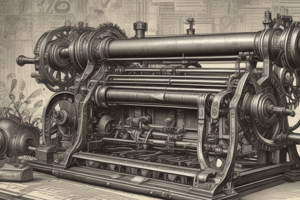Podcast
Questions and Answers
What was the main limitation of Gutenberg's letterforms?
What was the main limitation of Gutenberg's letterforms?
- They limited the amount of text that could fit on a single page. (correct)
- They were too expensive to produce.
- They were not based on the popular handwriting of the time.
- They were not durable enough for daily use.
What was the motivation behind Nicola Jenson's creation of the first roman typeface?
What was the motivation behind Nicola Jenson's creation of the first roman typeface?
- To create a more expensive font
- To create a more decorative font
- To allow for more words to be on a page, resulting in shorter books and faster setup times (correct)
- To mimic the handwriting of the time
What was the basis of Gutenberg's letterforms?
What was the basis of Gutenberg's letterforms?
- Blackletter calligraphy (correct)
- Italian humanist writing
- Typographic principles
- Roman typeface
What was the significance of Nicola Jenson's typeface?
What was the significance of Nicola Jenson's typeface?
What was the profession of Johannes Gutenberg?
What was the profession of Johannes Gutenberg?
What is the name of the font created by Bruce Rogers in 1914, based on Jenson's Roman type?
What is the name of the font created by Bruce Rogers in 1914, based on Jenson's Roman type?
What was the main reason behind the creation of the Italic type of font?
What was the main reason behind the creation of the Italic type of font?
What was the major challenge faced by readers while reading Italic fonts?
What was the major challenge faced by readers while reading Italic fonts?
Who created the 'Old Style' typeface in 1734?
Who created the 'Old Style' typeface in 1734?
What was the distinctive feature of John Baskerville's transitional typefaces?
What was the distinctive feature of John Baskerville's transitional typefaces?
What was the main inspiration behind the creation of Sans Serif type?
What was the main inspiration behind the creation of Sans Serif type?
Who developed the first commercially available slab serif, 'Antique', in 1815?
Who developed the first commercially available slab serif, 'Antique', in 1815?
Flashcards are hidden until you start studying
Study Notes
History of Typography
- Typography has a rich history that spans centuries, with significant developments in font styles and printing technology.
Early Printing Press (15th century)
- Johannes Gutenberg invented the printing press, allowing for mass production of books quickly and cheaply.
- Gutenberg's letterforms were based on Blackletter calligraphy, but limited the amount of text that could fit on a single page.
Roman Typeface (1470)
- Nicola Jenson created the first Roman typeface, based on blackletter and Italian humanist writing.
- Jenson's typeface allowed for more words on a page, resulting in shorter books and faster setup times.
Italic Font (1501)
- Aldus Manutius and Francesco Griffo created the Italic type of font to save space, which is now used to emphasize words.
Old Style Font (1734)
- William Calson created a typeface with more contrast between strokes of each letterform, known as the "Old Style" type.
Transitional Typefaces (1957)
- John Baskerville created transitional typefaces with more distinct letterforms, but was criticized for its thickness of strokes.
- Baskerville's typeface became popular in the 20th century and was named "the greatest printer England has ever produced."
Modern Serifs (1780s)
- Firmin Didot (France) and Giambittista Bodoni (Italy) created modern serifs, now named Didot and Bodoni.
- The key distinction between Didot and Bodoni lies in the appearance and placement of letterforms.
Slab Serifs (1815)
- Vincent Figgins created the first commercially available slab serif, called Antique, which stood out more than regular serifs.
Sans Serifs (1816)
- William Caslon IV developed "Two Lines English Egyptian"—also known as "Caslon Egyptian"—the first commercially available Sans Serif type.
- Sans serif type was influenced by block lettering used in classical antiquity, with minimal or missing serifs.
Studying That Suits You
Use AI to generate personalized quizzes and flashcards to suit your learning preferences.




